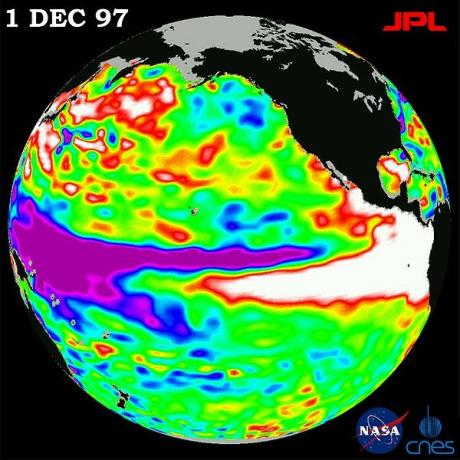What is El Niño? El Niño is the change in surface water temperature of the Pacific Ocean which begins when warm water in the western tropical Pacific Ocean moves east along the equator towards the coast of South America.
Usually this warm water is located near Indonesia and the Philippines. During an El Niño, the warmest surface waters in the Pacific are off northwest South America.
see more
Inequality: IBGE discloses the 10 worst states to…
Israel is the 4th strongest military power in the world; check the ranking
Characteristics

Meteorologists consider a weather event to be El Niño when they see both ocean temperatures and storm precipitation move eastward. Experts also note that trade winds weaken and even reverse their direction during the weather phenomenon.
These changes establish a feedback loop between the atmosphere and the ocean, which increases El Niño conditions.
The location of tropical storms shifts eastward during an El Niño because atmospheric moisture is fuel for storms, and the greatest amount of evaporation occurs above warmer ocean water.
El Niño and La Niña
There is also an opposite of a El Niño, called La Nina. This refers to times when the tropical eastern Pacific waters are cooler than normal and the trade winds blow more strongly than normal.
Collectively, El Niño and La Niña are part of an oscillation in the ocean-atmosphere system called the El Niño-Southern Oscillation, or ENSO cycle, which also has a neutral phase.
Causes
Scientists still don't understand in detail what triggers an El Niño cycle. Not all El Niños are the same, nor do the atmosphere and ocean always follow the same patterns from one El Niño to the next.
To predict an El Niño, scientists monitor temperatures in the upper 200 meters of the ocean. For example, in the spring of 2014, a very strong wave of warm water called the “Kelvin wave” crossed the Pacific, leading some meteorologists to predict a powerful El Niño for the winter of 2014.
However, the prediction failed because storms and winds did not follow the characteristics of the phenomenon, and feedbacks between atmosphere and ocean failed to develop.
Frequency
El Niño occurs every three to five years, but can occur as often as every two years or, rarely, every seven years. Typically, El Niños occur more frequently than La Niñas. Each event usually lasts for nine to 12 months. They often begin to form in the spring, peak in strength between December and January, and then decay in May of the following year.
Your strength can vary considerably between cycles. One of the strongest in recent decades was the El Niño that developed in 1997-98. El Niño was originally called El Niño de Navidad by Peruvian fishermen in the 1600s.
ADVERTISING
This name was used because of the phenomenon's tendency to arrive around Christmas time. El Niño climate records go back millions of years, with evidence of the cycle found in ice cores, deep sea muds, corals, caves and tree rings.
Action
During an El Niño, the trade winds weaken in the central and western Pacific. The surface water temperature in South America warms up because there is less upwelling of cold water to cool the surface.
Clouds and storms associated with warm ocean waters also move eastward. Warm water releases so much energy into the atmosphere that climate changes across the planet.
Consequences
The warmer waters in the central and eastern tropical Pacific Ocean have important effects on the world's climate. The biggest impacts are usually not felt until summer or fall in the Southern Hemisphere.
An El Niño creates stronger, more stable air in the Atlantic, which makes it harder for hurricanes to form. However, warmer-than-average ocean temperatures drive hurricanes in the eastern Pacific, contributing to more active tropical storm seasons.
ADVERTISING
Strong El Niños are also associated with above average rainfall in Peru, Chile, Brazil and Ecuador. Fish catches in the South American sea are typically lower than normal because marine life migrates north and south, following cooler water.
The phenomenon also affects precipitation in other areas, including Indonesia and northeastern South America, which tend to experience drier than normal conditions.
Temperatures in Australia and Southeast Asia are warmer than average. Drought caused by El Niño can be widespread, affecting southern Africa, India, Southeast Asia, Australia, the Pacific Islands and the Canadian prairies.

